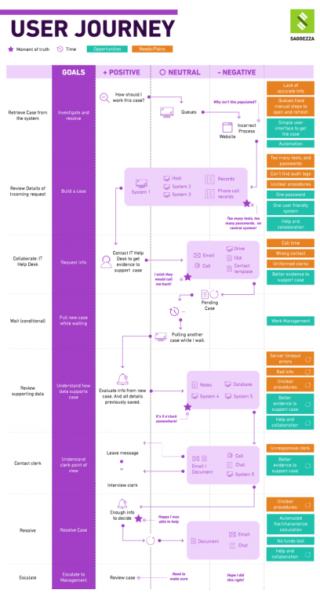
The Power of Journey Mapping and Unveiling of End-User Pain Points

Digital transformation is a process in itself. But what about the end-user and what they were accustomed to experiencing in the physical world that has now gone digital? Traditionally, banking meant customers did their banking at a physical branch. In today’s digital world, more and more, they have to rely on online banking transactions. This digital experience is especially challenging for individuals who are disabled or of an older generation since adapting to new tools may not be as easy for them because of their habits, comfort and accessibility to new technologies. The same is true for the employee experience; employees are now subject to working under remote conditions, forced into accessing different tools via secure remote access. On the brink of change, how do these transformations impact your employees productivity? These insights can be visually depicted in a journey map.
Journey Maps in Banking, Financial Services, and Insurance Industries
The increasing competition and digital transformation of companies in the banking, financial services, and insurance sectors result in an increased importance of and need for better user experiences. These companies are multidimensional, spanning across geographies, customer segments, and product offerings. Capturing the varying needs and behaviors of users is paramount when optimizing the user experience.
The decisions users make, especially in finance, are usually irreversible and could potentially have dire consequences. To mitigate the risk, users’ decisions must be supported with fast-changing, accessible real-time data. This data typically comes from a variety of sources such as market news, credit ratings, regulations, and compliance.
In addition, today’s customers also interact with a company through a variety of channels, and those employees tasked with responding must now navigate through a complex landscape of platforms to deliver an optimal end-user experience. This omnichannel array of digital communication creates challenges for companies to illustrate the complexity of user journeys in order to find potential opportunities for improvement.
A Journey Map Defined
It’s important to distinguish the activity (mapping) and the output (map).
Journey mapping is a collaborative activity that is used to capture and externalize information about a user’s actions and needs throughout interactions with a product or service. The output is an organized, visual representation of those insights.
In order to see the value of a journey mapping activity, the output should be a compelling artifact by which the stakeholders can have user-centered conversations.
Important things to consider when mapping user journeys
Process maps are usually and inaccurately called user journey maps. There are major differences between the two. A process map reflects the company’s perspective, whereas a user journey map puts the user in the center and enables stakeholders to empathize with the user. Moreover, a process map can be done with a specific department or business unit related to the process. A user journey, on the other hand, requires a cross-functional conversation since multiple disciplines/services contribute to the formation of the experience a user has with a company’s product or service.
A user’s journey with a product does not always have to be finite. However, even for finite journeys, the focus should be defined. Touchpoints a user has with various business units within an organization can be dependent on each other, sometimes creating layers of backend services that support a single user touchpoint on the journey.
Boundaries

With this interdependent structure, the need to create boundaries arises. Boundaries are perceptual and artificial by nature because everything is connected to everything. Drawing these boundaries not only determines the start and end of a journey that needs to be mapped, but also builds a consensus on the purpose of the mapping activity.
It’s crucial to avoid drawing these boundaries too narrow or broad. Boundaries that are drawn too broadly will increase the complexity of the journey and damage the storytelling opportunity. If boundaries are too narrow, it would lead to a limited vision of the user. Making decisions based on a narrow vision causes unintended and uncalculated consequences. For instance, if a user’s journey for opening a bank account focuses only on digital touchpoints, it will certainly miss the important steps – and all the touchpoints where the user switches to the interaction channel.
Another point to consider for boundaries is taking both behavioral and ecological perspectives into account. User actions, thoughts, motivations, emotions that are demonstrated on a user journey constitute the behavioral aspect and they stem from the user perspective. On the other hand, ecological perspective shows the different touchpoints, channels, environment and their effects on the user. The steps and actions a financial analyst takes to develop recommendations on operational efficiencies, as well as his/her aspirations, intentions and thought processes, portray the behavioral point of view on a journey. Yet, the ecological perspective includes factors such as where the operational measures are made available to him/her(e.g on a web-app, intranet, wall-mounted dashboard monitors), manager’s demands, time of the year/quarter and relationship dynamics with his/her colleagues.
Value of Journey Maps
Users and touchpoints are all components of a system. A journey map’s sole purpose is not only understanding and identifying these components, but also revealing the dependencies and interactions between them. On a journey map, companies can also see the consequences of these interactions in the form of moments of truth, user pain points, or high points. One of the most significant values regarding those pain points is being able to pinpoint the root cause of those pain points. These pain points represent opportunity areas where a company can make a design intervention in their product or service.
However, a meaningful design intervention cannot happen if a conversation around the user journey does not take place. Journey maps serve as internal guides that enable those conversations. It’s crucial to make use of the journey map as an output.
As Jim Kallbach, the author of Mapping Experiences mentions, “The conversation doesn’t end with the workshop -it’s ongoing”.
Journey maps help stakeholders gain the empathy of end-users while facilitating the ideation within a problem space bounded per user insights. In order to see the real value, companies need to take actions based on the output, so they can tackle the right problems.
References:
- James Kalbach, J. (2016). Mapping Experiences: A Complete Guide to Creating Value through Journeys, Blueprints, and Diagrams, O’Reilly Media
- Paying Attention To Where Attention Is Placed In The Rise of System(S) Change(S) Zaid Khan & David Ing RSD8, Chicago, IL October 19, 2019




